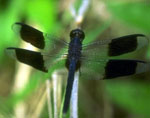 |
 |
Introduction Teachers Guide
Insects Birds Bats Pterosaurs Fish Wing Structures
Gliding Soaring Flapping Migration
Seed Helicopter Build a Bird
Ornithopter Zone Web Site Links |
Insects Most insects have four wings, but their arrangement varies. In dragonflies, the four wings are all about the same size. The wings can flap out-of-phase: front wings rise as back wings fall. Many insects, though, flap their wings in unison. In butterflies and wasps, the larger front wings overlap the hind wings, and at first glance, it appears there are only two wings. Flies have no hind wings at all, just tiny vibrating clubs that help them sense direction. A beetleís front wings form protective wing covers called elytra. In flight these provide some lift, but they donít flap much. The wings can be several times larger than the elytra but fold neatly underneath. More than 300 million years ago, insects were the first animals to fly. Some people wonder how flight could be the result of gradual evolution. Before any flying insects, there would have to be some insects with wings too small to fly. Wouldn't those small wings merely get in the way, making it difficult for the insect to survive? Flight can evolve only if rudimentary wings have some benefit to the organism. Some insects today do have small wings, and they offer a clue as to how flight could have evolved. The stonefly is an insect that spends its larval stage on the bottom of a creek. Most stoneflies can fly when they become adults. But some stoneflies have small wings which they use as sails, to help them scoot across the surface of the water. Other small-winged stonefly species can flap their wings, so they can skim across the water, even on windless days. These stoneflies show one way flight could have evolved in insects. |
||||||||
 Insects
are the most diverse group of organisms. There are probably several
million different kinds, or species, many of which have yet to be
discovered by scientists. The smallest insects are too small to
see. The largest flying insect is the goliath beetle of the African
rain forest. It can weigh over 100 grams, about the size of a large
jay.
Insects
are the most diverse group of organisms. There are probably several
million different kinds, or species, many of which have yet to be
discovered by scientists. The smallest insects are too small to
see. The largest flying insect is the goliath beetle of the African
rain forest. It can weigh over 100 grams, about the size of a large
jay.